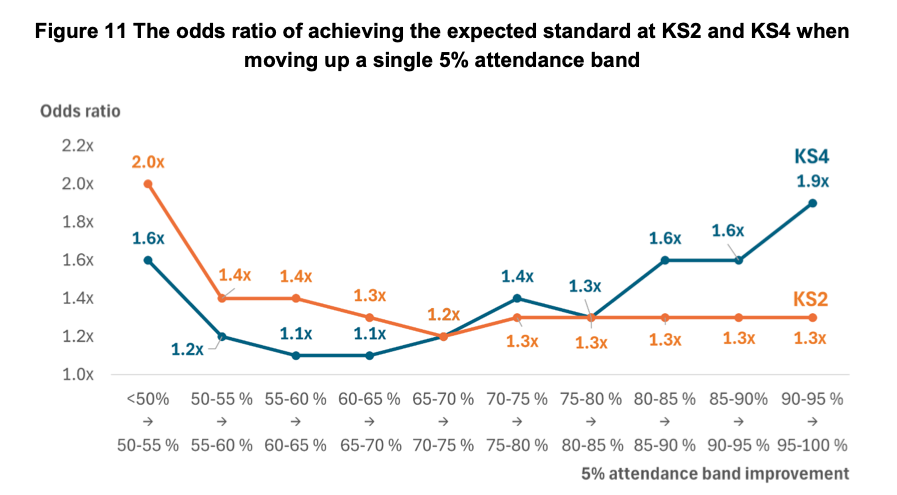The odds of year 11 pupils achieving a grade 5 in English and maths almost double if their attendance is over 95 per cent, compared to those who miss between 5 and 10 per cent of lessons, government attendance research suggests.
The Department for Education (DfE) has published a report which examines the link between attendance and attainment of pupils taking SATs and GCSEs.
They analysed school census data from schools and exam and test results, using a model which controlled for the effect of other factors which may affect a pupil’s attainment, such as their characteristics.
It comes after the Education Policy Institute (EPI) found school absences between 2019 and 2023 were a “key, and growing, driver of the disadvantage gap”.
Here’s what we learned from the government research.
1. Attendance is key in year 11…
The odds of pupils in year 11 achieving a grade 5 in English and maths were 1.9 times higher than those who only attended 90 to 95 per cent of the time.
Missing just ten days of year 11, the report said, halved the odds of achieving a grade 5 in the subjects.

2. …and year 6
The research also found the odds of year 6 pupils reaching the expected standard in reading, writing and maths were 1.3 times higher among those whose attendance was 95 per cent or higher than those with 90 to 95 per cent attendance.
Missing just 10 days of year six reduced the odds of reaching the expected standard by around 25 per cent.
3. Poorer pupils have lower attendance and attainment
The report found “strong evidence that other factors may affect a pupil’s attainment”, such as their eligibility for free school meals, or special educational needs and disabilities.
Pupils eligible for free school meals are “under-represented in the higher attendance bands”, accounting for only 20 per cent of year 6 pupils in the 95 to 100 per cent attendance band but 69 per cent of those in the 65 to 70 per cent band.
27.3 per cent of year 6 pupils nationally are eligible for free school meals.
At year 11, only 14 per cent of pupils with attendance above 95 per cent were eligible for free school meals, compared to 21.3 per cent of year 11s nationally.
Pupils eligible for free school meals also had a lower likelihood of reaching the expected standard at key stage 2 or getting a grade 5 at GCSE.
Children with SEND also had lower attendance rates and were less likely to reach the expected standards.














Hmmm. I’m not sure that the causal link in the headline is borne out by the data in the article. Shouldn’t the headline be “Affluence dramatically increases odds of high attainment and attendance”?
Pseudo statistics like that are not only useless but also misleading. Throwing numbers at the public to justify ineffective fines on parents. Where are the numbers which show correlation EHCP/SEND on attendance for example? Exam results are not caused by single factor but compound of multiple ones in addition to some factors causing other ones to appear. Where is assesment of what caused that <90 attendance with failed exams. One thing is sure those were not term time holidays what caused those results, but mental, health and household situation related
Worse attendance is a symptom of problems, not the cause.
This is correlation, not causation.
I’m sick of this push for attendence over everything else over the wellbeing of the child.
Fines pushing families into further poverty. Yeah that will help the child learn!
Taking them away from their parents or giving their parents convictions for the absences, yeah that will help improve their learning and education and have them able to focus on their education.
Blame absences rather than the broken system that is one size fits all that tries to bash square kids through round peg holes
These kids problem isn’t absences it’s lacknof support lack of differentiated education…. it enrages me they go after parents and abscence rather than the major problems in the education system great deflection